duplex study. Duplex vessels of the head and neck: how the procedure goes, the pros and cons
Qualitative diagnostics of diseases of arteries and veins in the area of the brain and cervical spine makes it possible to detect dangerous pathologies, life threatening patient, long before the manifestation of their clinical signs and start timely adequate treatment. duplex scanning vessels of the head and neck - a non-invasive modern technique, which is a type of ultrasound, with which you can visualize each artery and evaluate the speed of blood flow in them. In this case, the tissues that surround the vessels are visible.
UZDS (ultrasonic duplex scanning) is based on the possibilities of practical use of the properties of ultra sound wave, which, reflected from the erythrocytes moving in the vessels, makes it possible to obtain an image of the vessel under study.
This technique allows you to effectively explore both extracranial (cervical) and intracranial (located inside the brain) veins and arteries.
The doctor talks about the diagnosis ultrasound diagnostics Irina Gennadievna Maslova:
Duplex research is based on two diagnostic technologies. Firstly, it is ultrasonic radiation, configured in a pulsed mode, due to which an image is displayed on the monitor. Studying it, the specialist evaluates the structure of tissues and looks at the vessels. Secondly, the Doppler effect, which involves the assessment of a moving object, which is the blood flow, by reflected ultrasound on different areas veins.
When the image is fed to the monitor, a two-dimensional image is formed along and across the arteries.
The use of such a non-invasive diagnostic method necessary to obtain information that reflects changes in the state of blood vessels, as well as their effect on blood flow. Transcranial vascular duplex scanning (TCDS) allows valuable research to detect changes that occur in the tissues and arteries of the brain, which makes it possible to diagnose brain lesions and establish control over the course pathological process.
This method provides the following information:
- The condition of the walls of the vessels of the neck and head;
- State vascular tissue;
- Presence of stenosis and assessment of its severity;
- Disturbances in the flow of the bloodstream;
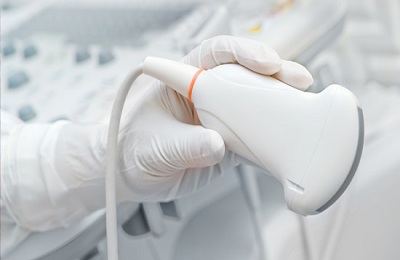
- Anatomical features circulatory system in the head and neck area;
- The presence of formations inside the vascular channels;
- Deviations associated with a change in the course of the arteries.
To obtain the most reliable information, experts use modern technology, with which you can carry out the so-called color scanning (CDS) - the ability to display a color sketch of blood flow on the monitor, which facilitates the process of determining its speed on different areas.
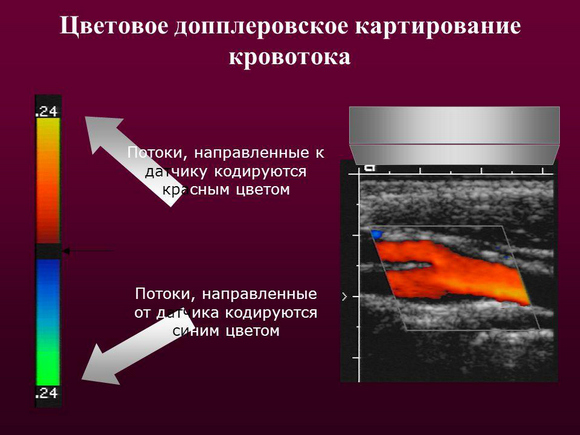
Color Doppler (Color Doppler) is a type of manipulation based on the Doppler effect. In this case, data on the speed of movement of structures is displayed in different colors. In particular, the red color determines the speed of blood flow towards the sensor, and the lighter the shade, the lower the speed. The blue color in the study is the blood flow velocity in the direction away from the sensor. With the help of this technique, not only a specific vascular pathology is determined, but it is also possible to distinguish a benign process from a malignant one, to identify the tendency of the tumor to further growth and spread.
Indications for carrying out. What pathologies are revealed by the procedure?
Intracranial duplex, which involves the study of veins and arteries located in the cranial cavity, is indicated for patients who have the following complaints:
- Regular headaches;
- dizziness;
- Noise in the head or ears;
- fainting;
The doctor of ultrasound diagnostics Murat Medzhidovich Nagaplev tells about the indications for the examination:
- Manifestations inappropriate behavior;
- Weakness and numbness of the limbs;
- Violation visual functions;
- Loss of coordination combined with shaky, unsteady gait;
- Deviations in the reproduction of speech or its understanding.
TKDS reveals circulatory disorders in the head area. It is appointed upon discovery the following pathologies:

- intracranial hypertension;
- Lesions of intracranial vascular channels.
Scanning of extracranial vessels outside the skull and supplying blood to the brain is performed with the following pathological signs appearing in the patient:
- Violation of the ability to remember information;
- Inability to concentrate on anything;
- Dizziness, intense headaches;
- Coordination disorders.
The arteries and veins of the cervical region should also be examined if an operation is necessary to intervene in the vessels of the heart or directly in the structure of the muscle, as well as in identifying pathologies of the neck organs that can lead to squeezing of the vessels located in this area.
Duplex scanning of the vessels of the brain and cervical region is a procedure that should be carried out routinely (once a year), even in the absence of any complaints, in the following cases:
- If the patient is older than 40 years (men) or 45 years (women);
- If you have close relatives who have diseases such as diabetes, hypertension, ischemic disease;
- If the patient is an experienced smoker;

- With previous surgical interventions on the spinal cord or brain;
- With a stroke or disorder cerebral circulation in history;
- In the presence of .
Ultrasound duplex scanning is used to diagnose the following pathologies:
- venous thrombosis, thrombophlebitis, thromboembolism pulmonary artery;
- Anomalies and injuries of the veins;
- Varicose veins;
- Aneurysm;
Rehabilitator Sergei Nikolaevich Agapkin tells more about brain aneurysm:
- The degree of blood flow deficiency;
- Atherosclerosis;
- Ischemia;
- angiopathy;
- Vasculitis.
A method such as ultrasound is characterized by high information content, painlessness, and the absence of harmful effects on the body, since the manipulation does not require equipment with radiation.
How is the diagnosis carried out?
Diagnostics main arteries heads - a safe measure that, if necessary, can be prescribed to pregnant women or a child. A relative contraindication to the procedure is the general serious condition of the patient or the presence of diseases that make it impossible for the patient to take a horizontal position in which the procedure is performed.

Survey of large cervical arteries
The examination lasts no more than half an hour. Any preliminary preparation scanning is not required. The subject will only need one thing - not to take on the eve of substances or drugs that affect vascular tone and distort big picture their states. These include caffeine, nicotine-containing substances, energy and alcoholic drinks. You should not visit the sauna and bath before duplex scanning.
Duplex scanning in progress in the following way:
- The patient is in a supine position. The specialist fixes the head in such a way that it is in an elevated position, for which they put a roller under the neck. The head is turned in the direction opposite to that in the area of which the study is being carried out;
- A specialist with the help of a sensor conducts over the area of the location of the vessels. Previously, to facilitate the examination, a gel with a special composition is applied to the surface of the skin. The resulting image is fed to the monitor;
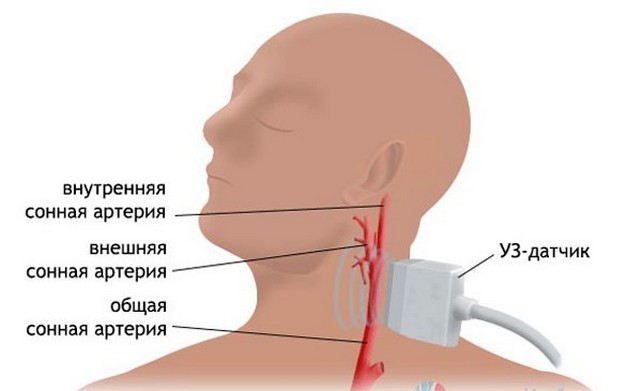
- The examination begins with the diagnosis of the carotid artery before entering the skull, examining it in different planes;
- When examining the brain, such areas as the occipital bone, temporal and supraorbital regions, the junction occipital bone with the spine.
During the duplex of the vessels of the head and neck, functional tests for studying autonomic regulation. For these purposes, the specialist may ask the subject to hold his breath, cough, slightly change the position of the body.
As for the cost of the procedure, it is not too high and, depending on the level medical institution and the city in which it is located, ranges from 2300 to 4000 rubles.
Results and their interpretation
The assessment of the state of the arteries and veins of the head and cervical region is carried out according to such indicators as the thickness of the walls of the vessels, the nature and speed of blood flow, the ratio between the minimum and maximum speeds.
The level of Doppler indicators of the condition arterial vessels expressed in numbers. So, the norm for the thickness of the artery wall is from 0.9 to 1.1. Normal maximum systolic rate should not exceed 0.9, peak speed in diastole - less than 0.5.
Deciphering the results allows you to get the following signs of vascular pathology:
- An increase in wall thickness and narrowing of the artery by less than 20% indicates atherosclerosis;
- diffuse change wall thickness indicates vasculitis;
- The presence of a fistula between the veins and arteries is a sign of malformations.
A lecture on the symptoms and treatment of vascular atherosclerosis is given by the therapist Yuzef Viktorovich Krinitsky:
The examination protocol allows the specialist to determine the most early signs disease before it manifests clinical symptoms.
The advantages of duplex scanning of the vessels of the head and neck are that it is a reliable method, which does not require the introduction of any substances into the patient's blood, as well as exposure x-rays which may adversely affect health. The diagnostic method has no contraindications. In addition, the price of the procedure is not too high, which will allow any patient to quickly and accurately determine the state of the vessels of the neck and head.
Duplex scanning of the brachiocephalic arteries (BCA) is a comprehensive ultrasound examination of the vessels of the head and neck. Non-invasive, safe, no strict contraindications and age restrictions combined with a fairly high information content make it one of the main diagnostic techniques in angioneurology.
The essence of the method

Duplex scanning is based on reflection ultrasonic waves from various fabrics human body. This study includes two components: vascular scanning (B-mode) and Doppler. They can be used simultaneously or alternately, depending on the apparatus and skills of the ultrasound specialist.
B-mode in duplex scanning is a two-dimensional grayscale echography. This is what is called a "normal" ultrasound. The piezocrystals located in the sensor of the device under the action of an alternating electric current generate ultrasonic waves. They are focused and directed to the area of the human body being examined. Such radiation does not cause discomfort and does no harm. Fabrics and anatomical formations have different density and ability to absorb and reflect ultrasonic rays. The sensor perceives the reflected signal, and based on the difference between the emitted and reflected wave, the device's program builds a two-dimensional (planar) black and white image.
B-mode allows you to visualize vessels of different calibers and surrounding tissues. At the same time, the doctor evaluates the structure of their walls, detects the presence of blood clots and plaques, measures the diameter of arteries and veins, determines their course and the presence of pathological expansions or narrowings.
Doppler mode is a dynamic study that helps to evaluate blood flow parameters in real time. The method is based on the Doppler effect. This is the change in perceived frequency and wavelength when a signal is reflected from a moving object. The ultrasound generated by the transducer is reflected from shaped elements blood (erythrocytes and other cells) and is captured by the device. This allows you to evaluate the direction and speed of blood flow, its linearity and uniformity. Slowing, the appearance of eddies (turbulence) or retrograde movement of blood indicate the presence of some structural changes.
Thanks to the combination of two modes, duplex scanning provides the doctor with information about the causes of impaired blood supply to the brain and the degree of existing blood flow deficiency.
What vessels are examined
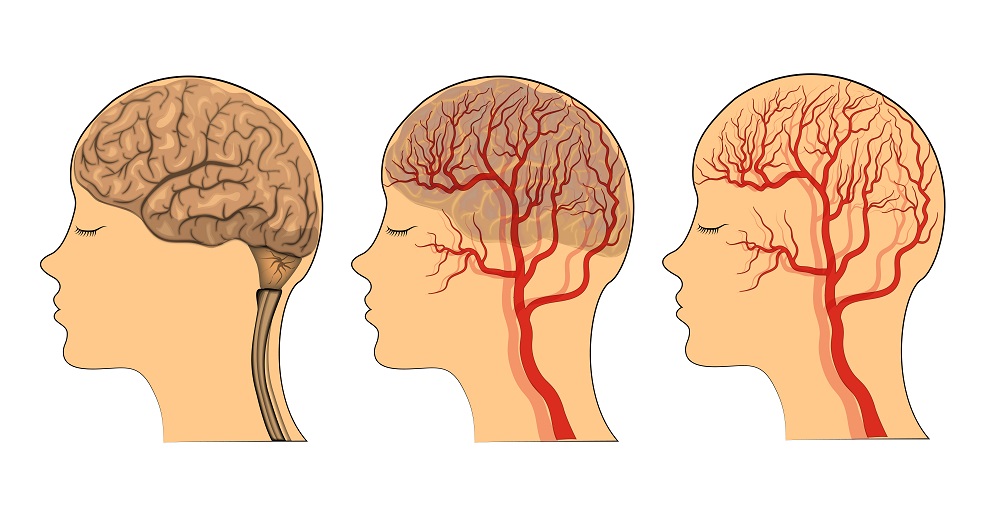
Extracranial and some intracranial vessels are subject to examination. From the vessels of the neck, a part of the brachiocephalic trunk, the common carotid arteries and the area of their bifurcation, the extracranial part of the internal carotid artery, and the external carotid arteries are examined. The temporal and supratrochlear arteries can also be examined, large veins after their exit from the skull, the venous vertebral plexus.
With transcranial duplex scanning, the doctor examines the vessels located in the projection of acoustic windows (temples, eye sockets, foramen magnum). It is these parts of the skull in an adult that transmit a sufficient amount of ultrasound waves for research. In a child, scanning is also carried out through open fontanelles, which significantly expands the diagnostic capabilities of the method.
Transcranial duplex scanning allows you to examine the intracranial part of the internal carotid and vertebral arteries, cerebral arteries(anterior, middle, posterior), basilar artery.
What does a duplex scan of the BCA show?
With the help of duplex scanning of the vessels of the head and neck, it is possible to identify:
- atherosclerotic lesions of the arteries with narrowing of their lumen, the formation of a parietal thrombus;
- the presence of pathological tortuosity (kinging) of the vessels;
- various shapes and origin;
- anomalies in the structure, branching and course of blood vessels;
- vasculitis of various etiologies;
- thrombosis;
- violations of the integrity of the walls of blood vessels;
- change in the elasticity of the vascular walls;
- the presence of pathological arteriovenous or arterio-arterial shunts (places of abnormal discharge of blood into another vessel);
- violations of the compensatory-regulatory mechanism for maintaining the stability of the blood supply to the brain;
- the degree of blood flow deficiency in the narrowed areas of the vessels, the presence of pathological blood flow and a change in its uniformity and direction;
- the state of the collateral network, its functionality and the degree of compensation for insufficient blood flow through the main arteries.
Duplex scanning makes it possible to identify the causes of a decrease in the patency of the main vessels of the head and neck and at the same time assess the nature and degree of the resulting functional disorders.
When is ABC Duplex Scanning Ordered?

Examination of the vessels of the head and neck is indicated for clinical signs or chronic insufficiency cerebral circulation, to control the effectiveness of therapy, with systemic thrombolysis. The basis for the appointment of a duplex scan may be the patient's complaints of headaches, memory loss, sudden deterioration in vision, fainting, noise in the head and , weakness in the arm and leg, difficulty in swallowing. Found on examination central paresis facial and oculomotor muscles, limb muscles, progressive cognitive impairment, vestibulo-atactic syndrome, bulbar paralysis are also the basis for diagnostic search with examination of the main vessels of the head and neck.
Quite often, duplex scanning is included in the program of routine examination of persons at risk for the development of cerebrovascular diseases. This includes smokers, patients with diabetes, arterial hypertension, obesity, identified dyslipidemia, systemic diseases. And duplex scanning of the veins of the brachiocephalic basin is indicated for suspected thrombosis and thromboembolism.
Research Procedure
No special preparation is required before duplex scanning. It is advisable to stop taking drugs within a few days that can affect the tone and patency of blood vessels. This is agreed with the attending physician, because many medicines require regular intake and cannot be canceled. The patient must inform the ultrasound doctor about all the drugs used. It is also advisable the day before to refrain from drinking alcohol, intense physical activity, baths and saunas.
With duplex scanning of the vessels of the head and neck, the patient lies on his back, if necessary, the doctor asks him to turn on his side. It is undesirable to talk and without permission to change the position of the body. If there is discomfort in the area of the heart, dizziness and other complaints, it is necessary to inform the doctor conducting the study about this.
During duplex scanning, the doctor presses the probe with the contact gel applied to the skin on the lateral surfaces of the neck, supra- and suboccipital, supraclavicular and temporal regions. And when examining the supratrochlear artery and orbital vessels, the area above the inner corner of the eye is examined. When using the Doppler mode, the doctor can use functional tests to assess the state of blood circulation autoregulation. To do this, short-term compression (compression) of the carotid arteries is carried out with fingers or a sensor, the head end of the couch is lowered. The doctor may also ask the patient to sit down, turn his head, breathe often, hold his breath, strain.
In conclusion, the doctor indicates the diameter of the examined vessels, the speed and nature of the blood flow in them, the presence of narrowing (stenosis) and blood clots, pathological changes vascular wall. The state and thickness of the intima-media complex (IMC) are also described, and the identified blood flow deficit is additionally indicated as a percentage.
The interpretation of the results of duplex scanning of the vessels of the head and neck is carried out by the attending physician, who also decides on the tactics further treatment patient. Ultrasound specialist is unable to recommend appointments certain drugs or the need for surgical intervention.
Doctor functional diagnostics Murat Nagaplev talks about duplex scanning of the vessels of the head and neck.
Medicine constantly presents new diagnostic methods to society serious pathologies. Treatment Success various diseases depends on their timely detection, appointment necessary therapy. Duplex scanning of vessels of the head and neck – innovative way research that allows you to see in a two-dimensional projection the smallest tubular hollow formations human body. The non-invasive nature of the technique facilitates the procedure, does not require recovery after the manipulation.
What is duplex vascular scanning
How to check the head in a non-invasive way? Unique properties Ultrasounds help it pass through the tissues of the human body and, reflected from blood cells, send a signal in the form of an image of the area under study to the screen of the diagnostician's monitor. Through duplex scanning of the vessels of the head and neck, a specialist can evaluate blood hemodynamic parameters, obtain information about anatomical features veins and arteries. Different Doppler technologies use the properties of the sound wave in the same way, but have different functionality:
- UZDG (ultrasound dopplerography). This study helps to assess the patency of the vessels of the brain, neck, and other organs. UZDG carries only one functional load– determination of hemodynamics.
- duplex ultrasound scan. Using this method, it is possible to diagnose the presence of atherosclerotic plaques, blood clots in the arteries and veins, contributing to the narrowing of the lumen of the vessels. During monitoring, a tubular formation with surrounding tissues is visualized. Duplex scanning is divided into the following subspecies:
- extracranial - explores main vessels;
- intracranial - checks intracerebral "pools";
- transcranial - provides color duplex scanning of the brain.
- triplex scanning. Dopplerography of the vessels of the head and neck, during which, in addition to information about the intensity of blood movement, the diagnostician receives a color image of a tubular formation with surrounding tissues.
- Ultrasound procedure. Shows the "big picture" of the structure of arteries and veins. Doppler ultrasound helps to find out the characteristics of the movement of blood flow, to conduct an examination for the presence of pathologies.
Indications for the appointment of the study

The study of blood vessels of a planned nature should be carried out in without fail once a year. Anomaly detection on early stage development helps to avoid negative consequences associated with the progressive form of the disease, and take measures to prescribe the necessary therapy. Duplex scanning of the patency of the vessels of the head and neck is often prescribed to verify the results obtained during the implementation of MRI, USDG of vessels necks and heads. The indications for a duplex are the following symptoms:
- headache;
- dizziness;
- fainting;
- hand numbness;
- lack of coordination;
- memory loss;
- smoking;
- a history of stroke;
- cervical osteochondrosis;
- arterial hypertension;
- previously identified vascular dystonia;
- family ties with hypertensive or diabetic;
- vasculitis (inflammation of blood vessels).
How to prepare
Head and neck examination does not require the patient special training. On the day of the procedure, it is necessary to abandon the use of drugs that increase vascular tone: coffee, nicotine, tea, energy drinks. Cancellation of drugs that can distort ultrasound results- "Betaserk", "Cinnazirin" - requires a consultation with a neurologist. Before scanning, the patient will need to remove all foreign objects in the form of chains, hairpins, etc.
How is the procedure carried out
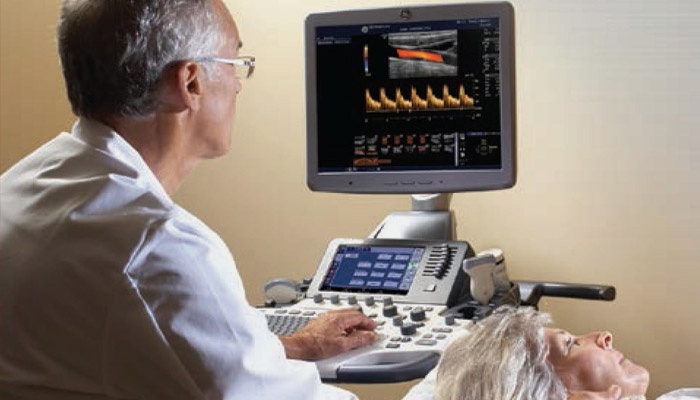
Duplex scanning can be done in the direction of the attending physician in the neurological departments of large city hospitals or go to the clinic according to the area of residence. The manipulation takes place general rule. The patient is placed on the couch, a hard pillow or roller is placed under the head, the head is taken away to the side opposite to the sensor.
Before starting the procedure, the doctor applies a little special gel to the area under study, with which you can easily “drive” the transducer over the surface of the skin, analyzing the arterial and venous channels. The vessels of the brain are checked through the bones of the skull. Pre skin processed with a water-soluble gel, then the doctor places the sensors on the following areas:
- temples;
- above the eye sockets;
- alignment of the occipital bone with the spine;
- occipital bone.
Deciphering the results

At the end of the examination, the doctor receives comprehensive information about the condition of the arteries and veins. The analysis of the venous bed practically does not contain digital data, but includes the following parameters:
- anatomy;
- patency;
- the speed of blood movement;
- the presence of abnormal formations inside the lumen.
Dopplerography of arterial vessels collects digital data that are compared with normal values. Satisfactory condition of the general and carotid arteries the presence of the following indicators can be considered:
- the limiting speed of blood movement in the artery is less than 0.9;
- percentage of stenosis - 0;
- peak speed in diastole - less than 0.5;
- absence of formations inside the lumen;
- wall thickness - 0.9-1.1.
Are there any contraindications
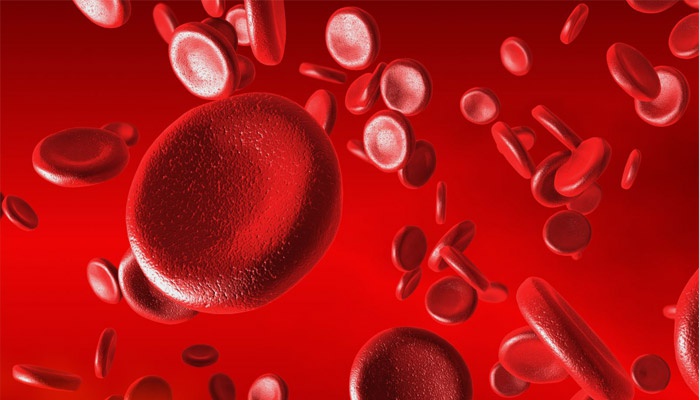
The advantage of duplex scanning is that negative impact on the human body. The non-invasive nature of the study helps to diagnose blood vessels in an adult and a child without any restrictions. Relative contraindications it could be considered serious condition patient or the presence of diseases that prevent the transition of the patient to horizontal position.
Video: what ultrasound of the vessels of the head and neck shows
Duplex scanning of the vessels of the head and neck is an ultrasonic examination of vessels that are extracranial (neck vessels) and intracranial (head vessels). it modern method diagnostics, which allows you to get a visualization of the lumen, its walls and identify functional indicators blood flow. It is widely used in neurology, neurosurgery, cardiology and other branches of medicine.
What is duplex scanning?
First of all, it is a non-invasive diagnostic method, which is available in almost all medical centers. The basis of diagnostic manipulation is the Doppler effect, which helps to calculate the speed of blood flow, determine the location of its possible violation. In addition, the possibility of examining the anatomical structure of the vessels, the presence of congenital or postoperative anomalies of the vascular bed, the identification of atherosclerotic plaques and blood clots provide the basis for making a diagnosis.
Ultrasound of the vessels of the neck
On the neck are one of the main vessels that supply blood to the brain. An examination using ultrasonic waves allows you to examine their structure, evaluate the lumen, and identify the presence of pathological structures (plaques, blood clots).
The atherosclerotic process occurs in the body simultaneously throughout the body, leads to damage, which causes vascular catastrophes (, heart attacks).
Assess prevalence vascular changes it is possible in areas of the body where the vessels are closely located and available for duplex scanning. Carrying out an ultrasound examination of the vessels of the neck makes it clear how they look vascular lesions throughout the body. In addition, it is possible to evaluate the influence of closely spaced bone structures directly on the vessels of the neck, and hence on the blood supply to the brain.
Duplex scanning of cerebral vessels can visualize the following parameters:
- evaluate the anatomical structure, anomalies or changes;
- determine the presence of atherosclerotic lesions: plaques, thickening of the intima-media complex (IMC);
- reveal venous congestion in the veins of the neck;
- assess the effect of the cervical spine on blood flow;
- identify vascular patency, occlusion, or the presence of a thrombus.
The attending physician can prescribe and evaluate the results of duplex scanning of extracranial vessels. Depending on the revealed changes, the tactics of treatment is chosen, the selection of drugs is carried out taking into account the course of the disease and individual features organism. In the future, to evaluate the effectiveness of therapy, it is also possible during an ultrasound examination.
Vascular ultrasound has the following indications:
- headache;
- dizziness, ;
- memory loss and disability;
- head injury;
- bouts of numbness of the fingers;
- high blood cholesterol;
- , ears;
- symptoms of developing acute violation cerebral circulation;
- cervical osteochondrosis.
How the study is done
On the eve of the examination, it is not recommended to take caffeine-containing drugs, drink alcohol or smoke. Also do not carry out the procedure after intravenous injections as this may affect the result. Any drugs that affect blood flow and blood pressure, except if the intake of these medicines is vital.
 The patient is located on the couch with his head thrown back and set aside in the direction opposite to the study. The probe of the ultrasonic device is installed on the neck, first on one side. Further evaluate vascular bundles neck on the other side. The duration of the study is individual, but on average lasts 10-15 minutes.
The patient is located on the couch with his head thrown back and set aside in the direction opposite to the study. The probe of the ultrasonic device is installed on the neck, first on one side. Further evaluate vascular bundles neck on the other side. The duration of the study is individual, but on average lasts 10-15 minutes.
Ultrasound examination of the vessels of the head
Duplex scanning of the vessels of the neck and brain visualizes the vessels not only located on the neck, but also blood supplying the brain, determining the blood flow through the intracranial vessels. Because the bone(skull) serves as an obstacle to the penetration of ultrasonic waves, so-called acoustic windows are used to conduct transcranial dopplerography: temporal region, orbits of the eyes, areas of the occipital bone and vertebrae.
Duplex examination of blood vessels is carried out with:
- chronic headache;
- neurocirculatory dystonia;
- violation of blood flow;
- dizziness and tinnitus;
- periodic fainting;
- suspicion of abnormally located cerebral vessels;
- assessment of the degree of atherosclerotic lesions of the vessels of the head;
How is a duplex examination of the vessels of the head and neck
On the eve of the study exclude vascular preparations that affect the results of the procedure, alcohol and nicotine. The examination is carried out lying on the couch. The ultrasonic sensor is installed on the back of the head, in the region of the orbit and temple. In the course of the diagnostic measure it will be necessary, at the request of the doctor, to turn your head to the side, breathe quickly or hold your breath. The duration of the procedure is no more than 15 minutes.
The results can be evaluated by the following indicators: pulsation and resistive indices, linear blood flow velocity and its nature, vessel diameter and percentage of thrombus occlusion, systolic-diastolic ratio.
Ultrasound duplex scanning of the vessels of the head and neck is a modern diagnostic method allowing not only to install accurate diagnosis but also evaluate the effectiveness of treatment. The examination is appointed by the attending physician. After receiving the results, he determines the further direction of therapy and selects medical preparations taking into account the characteristics of the course of the disease.
To date ultrasonic methods studies that can be used to diagnose vascular pathology brain are:

Duplex scanning of the vessels of the head and neck is recognized as the gold standard for diagnosing angiological pathology in this area. What is the essence of this method? How is it different from ultrasound and ultrasound? Who is shown this study and how to prepare for the procedure? We will answer these and many other questions in the article.
Feedback from our reader Victoria Mirnova
I was not used to trusting any information, but I decided to check and ordered a package. I noticed changes within a week. constant pain in the heart, heaviness, pressure surges that tormented me before - receded, and after 2 weeks they disappeared completely. Try it and you, and if anyone is interested, then below is a link to the article.
What is a duplex?
Duplex scanning combines the advantages of classical ultrasound and Doppler.
 This research makes it possible to:
This research makes it possible to:
- obtain an image of the vessel, evaluate its morphology (what conventional ultrasound can also do);
- visualize the flow of blood in the lumen of the vessel, evaluate its direction, intensity, as well as a number of other characteristics (what ultrasound allows you to do).
Thus, it is possible to evaluate two basic parameters - structure and function. In addition, duplex allows you to visualize atherosclerotic plaques, thrombi and emboli various genesis, pathological tortuosity of vessels, thickening or thinning of the vascular walls.
Modern ultrasound machines, which provide for the possibility of duplex scanning, produce a color image.
The resulting picture is displayed in the form of a cartogram, which contains information about the speed, direction, and intensity of blood flow. This option The technique is called color Doppler scanning (CDS).
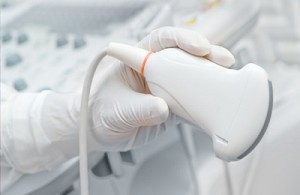 The extensive possibilities revealed by this method in the diagnosis of angiological pathology determine wide range indications for research.
The extensive possibilities revealed by this method in the diagnosis of angiological pathology determine wide range indications for research.
Using this method ultrasound diagnostics, it is possible to examine almost any vessels of the human body. Since in this article we are talking about the duplex of the head and neck, below we provide a list of vessels in this area, which are most often examined using this technique.

These are the main groups of vessels that are available for duplex scanning of the corresponding area.
The method of transcranial Doppler scanning (TCDS) does not lose its relevance. This study allows you to evaluate the blood flow in the same vessels that are available to the duplex. The disadvantage of the method is the inability to assess the morphology of the vascular bed. Therefore, transcranial doppler is used only when it is not possible to do a duplex.
For cleaning VESSELS, preventing blood clots and getting rid of CHOLESTEROL - our readers use a new natural preparation recommended by Elena Malysheva. The composition of the drug includes blueberry juice, clover flowers, native garlic concentrate, stone oil, and wild garlic juice.
Indications for the study
Let's start with the cases in which it is necessary to conduct a scheduled duplex scan of the head and neck area. Duplex scanning of cerebral vessels is indicated for performance:

Separately, it is necessary to analyze cases when the patient is concerned about certain symptoms, the diagnosis is not established, and it is recommended to perform an ultrasound examination. Symptoms that indicate the need for a duplex of the vessels of the head and neck include:

In the above cases, duplex scanning will reveal the pathology and establish a diagnosis. The effectiveness of the study is significantly increased when using the CDS mode, which has already been mentioned above.
There are several nosological units in the diagnosis of which the method of duplex scanning of cerebral vessels plays a decisive role. It:

In this way, modern techniques Ultrasound can diagnose many different pathological processes. An accurate diagnosis is the key right choice patient management tactics.
How is the research done?
Carrying out this type of ultrasound (including with CDS) does not require special preparation of the patient. The only thing the attending physician can ask for is the refusal to use substances that can distort the real picture. It's about about substances that significantly affect vascular tone.
Many of our readers for CLEANING VESSELS and lowering the level of CHOLESTEROL in the body actively use the well-known method based on Amaranth seeds and juice, discovered by Elena Malysheva. We strongly recommend that you familiarize yourself with this method.
 Therefore, on the eve of the duplex of the head and neck area, you should refuse to receive:
Therefore, on the eve of the duplex of the head and neck area, you should refuse to receive:
- nicotine-containing substances;
- caffeine-containing substances;
- alcohol, and energy drinks.
If the patient regularly takes drugs that affect vascular tone, then before conducting this type of ultrasound, he should discuss the issue of the drug regimen with the attending physician.
All types of ultrasound of the vessels of the head (including duplex with CDS) are carried out according to a single scheme. The patient is in the supine position, under the head - a special roller (or pillow).
The neck should be free, and the head should be turned in the direction opposite to the side of the examination. A special gel is applied to the skin, along which the sensor moves. The doctor places the sensor at certain points, which allows you to visualize the necessary link in the vascular bed.
Duplex is a simple, non-invasive and completely painless method. Wherein this study is extremely informative and efficient.
About the information content of this method
In some cases, the duplex of cerebral vessels allows solving complex diagnostic problems. Below we give a few examples in which case to solve the issues of diagnosis and choice medical tactics is not possible without the use of duplex scanning:

From the foregoing, it becomes clear that today duplex scanning of cerebral vessels plays an important role in the diagnosis of diseases in patients with neurological and angiosurgical profiles. Duplex provides a high quality of diagnostics, and consequently, subsequent treatment.
Do you still think that it is completely impossible to RESTORE blood vessels and ORGANISM!?
Have you ever tried to restore the work of the heart, brain or other organs after suffering pathologies and injuries? Judging by the fact that you are reading this article, you know firsthand what is:
- often occur discomfort in the head area (pain, dizziness)?
- You may suddenly feel weak and tired...
- constantly felt high blood pressure…
- about shortness of breath after the slightest physical tension and nothing to say...
Did you know that all these symptoms indicate an INCREASED level of CHOLESTEROL in your body? And all that is needed is to bring cholesterol back to normal. Now answer the question: does it suit you? Can ALL THESE SYMPTOMS be tolerated? And how much time have you already "leaked" on ineffective treatment? After all, sooner or later the SITUATION WILL AGAIN.
That's right - it's time to start ending this problem! Do you agree? That is why we decided to publish an exclusive interview with the head of the Institute of Cardiology of the Ministry of Health of Russia - Akchurin Renat Suleimanovich, in which he revealed the secret of TREATMENT of high cholesterol.

